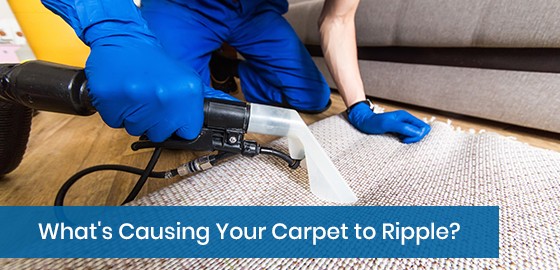What’s Causing Your Carpet to Ripple?

Whether you’ve got wall to wall carpets or an area rug in every room, spotting a ripple is never a good sign. Carpet ripples can be symptoms of stress to the material or damage to the fibres inside. You might find yourself tempted to stomp out the ripple, stretch the rug out or place heavy furniture on top to flatten it. However, this is rarely a good idea.
At RBC Clean, we specialize in carpet cleaning services in Markham and see plenty of rugs and carpets during the day. One of the things we’ve learned through our time as residential, commercial, and industrial cleaners is that carpets need to be treated with care.
In this blog, we’ll help you better understand what’s causing your carpet to ripple and how you can fix it.
Pulling Heavy Furniture on Your Carpet
If you notice a ripple in your carpet near a piece of furniture, it could be caused by a strain to the carpet material. When heavy furniture is dragged over the carpet rather than lifted over it and placed carefully on top, it stretches the carpet out. This causes ripples and waves in what should be a smooth rug.
Furniture induced carpet wrinkles are often found near heavy and awkward furniture like TV units and bookshelves. If you find you’re unable to lift these items by yourself, enlist the help of friends or family to get the job done without destroying your carpet. And when doing the heavy lifting, remember to always lift with your knees.
Humidity in Your Home
With years of experience as a carpet cleaning service in Markham, we understand how hot and humid the summer months get here in Ontario. Humidity causes many issues in a home setting, including carpet ripples.
The carpet fibres capture the humidity in the air, and when this moisture is unable to dry, it forces the carpet fibres to swell. Some carpets will retain their shape when the swelling subsides, and the fibres are dry once more. Others may remain rippled and creased even after the carpet dries.
A dehumidifier during the summer months is a great way to alleviate moisture in your home and protect your carpet from buckling. Another issue facing carpet owners in the humid months is the potential for mould and mildew development.
The Underpad is the Wrong Size or Type
If you flip your carpet over, you’d see a cushy piece of material on the other side. This is called an underpad, and it’s there to protect your floors, increase comfort, maintain acoustics, and insulate the space.
If the underpad is the wrong size for your carpet, it could force your carpet to stretch or buckle in certain areas. The only way to fix a ripple due to an underpad is to have the underpad replaced.
Carpet underpads not only come in various sizes, but they also come in different types. Some pads are stiffer than others and depending on the style of carpet on top; the stiffness could be too much or too little, causing ripples.
Your Carpet Installation Team Made a Mistake
Installing carpet isn’t an easy job, so it’s not surprising that from time to time wall to wall carpet isn’t stretched quite as tightly as it should be.
If the carpet isn’t stretched and secured exactly where it needs to stay, it runs the risk of buckling or sagging where it loosens from the wall. To ensure your carpet will stay put, be sure your installation team uses a power stretcher to ease the carpet into place.
Another mistake your installation team might make is installing a carpet in a new environment too quickly. It sounds strange for a carpet to require time to acclimate to a new home, but if the house it was in previously was dry and cool, and your home is warm and humid, it might not fit the way it did in its last home. Your carpet company should know to wait until the fibres have a chance to relax and prepare for their new environment.
Wetness and Delamination
Your carpet can get wet for several reasons. Whether a window gets left open in a rainstorm, or you spill a glass of water while crossing the floor, there is a chance the dampness could encourage delamination.
Delamination is when the primary backing on your carpet, between the fibres and the underpad, comes unstuck. Carpets are generally held together by a latex adhesive. When this begins to break down in the water, the top layer of material can slide off its base, causing it to ripple.
If you notice your carpet is damp, dry it as quickly as possible. Pressing down on damp spots with a towel is a great way to begin. You can also use a hairdryer on a low setting if you’re very careful.
What to Do if Your Carpet Ripples
If you notice your rug is beginning to ripple, don’t panic! There are ways to fix this issue. The first is preventing the above causes from taking place. The second is to contact your original carpet installation team and request they reinstall the carpets. The team may need to stretch the carpet to make it fit without buckling.
Whether your carpet is rippling, or you simply want to prevent it from doing so in the future, regular cleaning can help. When you clean your carpet, you lift out dirt, debris, and moisture, which could all cause delamination.
If you’re interested in learning more about why your carpet is rippling and how to fix it, call RBC Clean at 1-866-278-8208 or contact us here.


